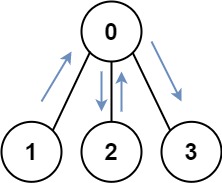Description
You have an undirected, connected graph of n nodes labeled from 0 to n - 1. You are given an array graph where graph[i] is a list of all the nodes connected with node i by an edge.
Return the length of the shortest path that visits every node. You may start and stop at any node, you may revisit nodes multiple times, and you may reuse edges.
Example 1:

Input: graph = [[1,2,3],[0],[0],[0]] Output: 4 Explanation: One possible path is [1,0,2,0,3]
Example 2:

Input: graph = [[1],[0,2,4],[1,3,4],[2],[1,2]] Output: 4 Explanation: One possible path is [0,1,4,2,3]
Constraints:
n == graph.length1 <= n <= 120 <= graph[i].length < ngraph[i]does not containi.- If
graph[a]containsb, thengraph[b]containsa. - The input graph is always connected.
Solution
Python3
class Solution:
def shortestPathLength(self, graph: List[List[int]]) -> int:
N = len(graph)
full_mask = (1 << N) - 1
visited = set()
queue = deque()
for node in range(N):
queue.append((node, 1 << node, 0))
visited.add((node, 1 << node))
while queue:
node, mask, edges = queue.popleft()
if mask == full_mask: return edges
for adj in graph[node]:
if (adj, mask | 1 << adj) not in visited:
visited.add((adj, mask | 1 << adj))
queue.append((adj, mask | 1 << adj, edges + 1))
return -1